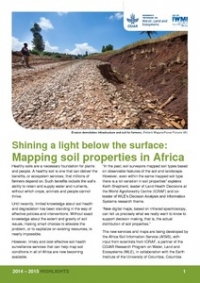Seventeen African countries are now using soil–plant spectral technology developed by the World Agroforestry Centre (ICRAF) and the CGIAR Research Program on Water, Land and Ecosystems (WLE) to restore soils and boost agricultural production, food security and livelihoods.
About 40% of soils in sub-Saharan Africa are low on nutrients. Widespread soil degradation hampers food production and leads to erosion and desertification. Globally, restoring just 12% of degraded agricultural land could increase smallholder incomes by USD 35-40 billion. However, African governments and other decision makers have long had little knowledge of where to implement what kind of restoration measures.
That’s why ICRAF, WLE and other partners, through the Africa Soil Information Service (AfSIS), have developed and shared technology that can quickly and cheaply measure and map soil and plant properties as well as match soil problems with appropriate solutions. This facilitates better targeting of soil management measures.
The Soil-Plant Spectral Diagnostics Laboratory has helped 14 government institutions, three private sector labs and one development agency to adopt the technology. Data has been used to create soil property maps of Africa at 250 m resolution (SoilGrids). The maps are being used by research and development agencies to guide land management decisions and by the World Soil Information organization to develop fertilizer recommendations for West Africa.
At national levels, AfSIS has helped develop state-of-the-art soil information systems based on spectral technology in Ethiopia (EthioSIS), Ghana (GhaSIS), Nigeria (NiSIS) and Tanzania (TanSIS). Nongovernmental organizations are also using the technology: One Acre Fund, for example, has established a rural spectral lab in Kenya.
Step Aston is the director of agriculture research at One Acre Fund, a direct farmer service organization that provides over 800,000 smallholder farmers with access to credit, agricultural inputs, and training across Africa. "Access to reliable and large-scale, but low-cost soil data is an important part of our ongoing efforts to develop more locally tailored soil fertility management recommendations, and monitoring the long-term impacts that our programs have on soil health," he said.
"To date, our soil lab has processed 50,000 soil samples, deriving insights to inform program strategy and decision-making in six countries. This effort would have been cost-prohibitive were it not for the technological breakthroughs and support delivered by the soil–plant diagnostic laboratory.”
Conservation International, Technoserve and The Nature Conservancy have commissioned spectral analysis services, while the World Bank Living Standards Measurement Study piloted soil spectral technology in Ethiopia and Uganda. In addition, ICRAF has provided advisory services to private companies now deploying spectral technology in 22 countries.
The technology is also helping smallholder farmers benefit from soil- and plant-testing services, through satellite-based data, mobile laboratories and handheld devices. A low-cost, handheld spectrometer was developed and tested, and it has potential to provide a quantum leap in accessibility of the technology for smallholder farmers, helping them solve soil challenges right on their farms.
Over the past four years, ICRAF has trained over 1,000 people from 17 countries on the technologies. More African and Asian countries plan to adopt the technology.











